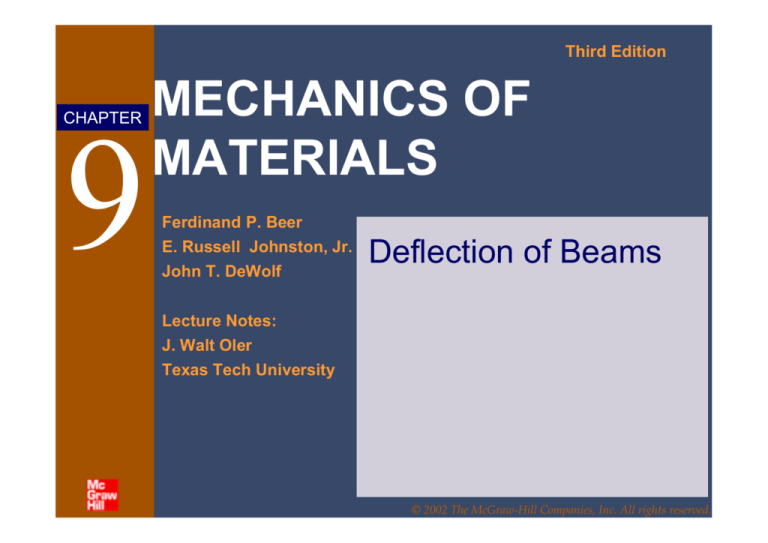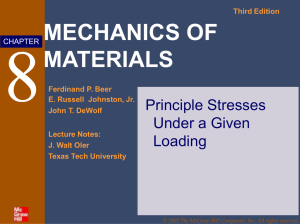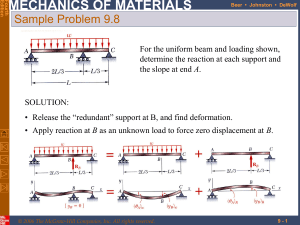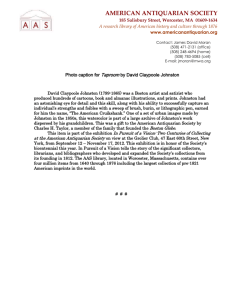
Third Edition
CHAPTER
MECHANICS OF
MATERIALS
Ferdinand P. Beer
E. Russell Johnston, Jr.
John T. DeWolf
Deflection of Beams
Lecture Notes:
J. Walt Oler
Texas Tech University
© 2002 The McGraw-Hill Companies, Inc. All rights reserved.
Third
Edition
MECHANICS OF MATERIALS
Beer • Johnston • DeWolf
Deflection of Beams
Deformation of a Beam Under Transverse
Loading
Equation of the Elastic Curve
Direct Determination of the Elastic Curve
From the Load Di...
Statically Indeterminate Beams
Sample Problem 9.1
Sample Problem 9.8
Moment-Area Theorems
Application to Cantilever Beams and
Beams With Symmetric ...
Bending Moment Diagrams by Parts
Sample Problem 9.11
Sample Problem 9.3
Application of Moment-Area Theorems to
Beams With Unsymme...
Method of Superposition
Maximum Deflection
Sample Problem 9.7
Use of Moment-Area Theorems With
Statically Indeterminate...
Application of Superposition to Statically
Indeterminate ...
© 2002 The McGraw-Hill Companies, Inc. All rights reserved.
9-2
Third
Edition
MECHANICS OF MATERIALS
Beer • Johnston • DeWolf
Deformation of a Beam Under Transverse Loading
• Relationship between bending moment and
curvature for pure bending remains valid for
general transverse loadings.
1
ρ
=
M ( x)
EI
• Cantilever beam subjected to concentrated
load at the free end,
1
ρ
=−
Px
EI
• Curvature varies linearly with x
1
• At the free end A, ρ = 0,
A
• At the support B,
© 2002 The McGraw-Hill Companies, Inc. All rights reserved.
1
ρB
ρA = ∞
≠ 0, ρ B =
EI
PL
9-3
Third
Edition
MECHANICS OF MATERIALS
Beer • Johnston • DeWolf
Deformation of a Beam Under Transverse Loading
• Overhanging beam
• Reactions at A and C
• Bending moment diagram
• Curvature is zero at points where the bending
moment is zero, i.e., at each end and at E.
1
ρ
=
M ( x)
EI
• Beam is concave upwards where the bending
moment is positive and concave downwards
where it is negative.
• Maximum curvature occurs where the moment
magnitude is a maximum.
• An equation for the beam shape or elastic curve
is required to determine maximum deflection
and slope.
© 2002 The McGraw-Hill Companies, Inc. All rights reserved.
9-4
Third
Edition
MECHANICS OF MATERIALS
Beer • Johnston • DeWolf
Equation of the Elastic Curve
• From elementary calculus, simplified for beam
parameters,
d2y
1
ρ
=
dx 2
2 ⎤3 2
⎡ ⎛ dy ⎞
⎢1 + ⎜ ⎟ ⎥
⎢⎣ ⎝ dx ⎠ ⎥⎦
≈
d2y
dx 2
• Substituting and integrating,
EI
1
ρ
= EI
d2y
dx
2
= M (x)
x
dy
= M ( x )dx + C1
EI θ ≈ EI
dx ∫
0
x
x
0
0
EI y = ∫ dx ∫ M ( x ) dx + C1x + C2
© 2002 The McGraw-Hill Companies, Inc. All rights reserved.
9-5
Third
Edition
MECHANICS OF MATERIALS
Beer • Johnston • DeWolf
Equation of the Elastic Curve
• Constants are determined from boundary
conditions
x
x
0
0
EI y = ∫ dx ∫ M ( x ) dx + C1x + C2
• Three cases for statically determinant beams,
– Simply supported beam
y A = 0,
yB = 0
– Overhanging beam
y A = 0,
yB = 0
– Cantilever beam
y A = 0, θ A = 0
• More complicated loadings require multiple
integrals and application of requirement for
continuity of displacement and slope.
© 2002 The McGraw-Hill Companies, Inc. All rights reserved.
9-6
Third
Edition
MECHANICS OF MATERIALS
Beer • Johnston • DeWolf
Direct Determination of the Elastic Curve From the
Load Distribution
• For a beam subjected to a distributed load,
d 2M
dM
= V (x)
dx
dV
=
= − w( x )
2
dx
dx
• Equation for beam displacement becomes
d 2M
dx
2
= EI
d4y
dx
4
= − w( x )
• Integrating four times yields
EI y ( x ) = − ∫ dx ∫ dx ∫ dx ∫ w( x )dx
+ 16 C1x3 + 12 C2 x 2 + C3 x + C4
• Constants are determined from boundary
conditions.
© 2002 The McGraw-Hill Companies, Inc. All rights reserved.
9-7
Third
Edition
MECHANICS OF MATERIALS
Beer • Johnston • DeWolf
Statically Indeterminate Beams
• Consider beam with fixed support at A and roller
support at B.
• From free-body diagram, note that there are four
unknown reaction components.
• Conditions for static equilibrium yield
∑ Fx = 0 ∑ Fy = 0 ∑ M A = 0
The beam is statically indeterminate.
• Also have the beam deflection equation,
x
x
0
0
EI y = ∫ dx ∫ M ( x ) dx + C1x + C2
which introduces two unknowns but provides
three additional equations from the boundary
conditions:
At x = 0, θ = 0 y = 0
© 2002 The McGraw-Hill Companies, Inc. All rights reserved.
At x = L, y = 0
9-8
Third
Edition
MECHANICS OF MATERIALS
Beer • Johnston • DeWolf
Sample Problem 9.1
SOLUTION:
• Develop an expression for M(x)
and derive differential equation for
elastic curve.
W 14 × 68
I = 723 in 4
P = 50 kips L = 15 ft
E = 29 × 106 psi
a = 4 ft
• Integrate differential equation twice
and apply boundary conditions to
obtain elastic curve.
For portion AB of the overhanging beam,
• Locate point of zero slope or point
(a) derive the equation for the elastic curve,
of maximum deflection.
(b) determine the maximum deflection,
• Evaluate corresponding maximum
(c) evaluate ymax.
deflection.
© 2002 The McGraw-Hill Companies, Inc. All rights reserved.
9-9
Third
Edition
MECHANICS OF MATERIALS
Beer • Johnston • DeWolf
Sample Problem 9.1
SOLUTION:
• Develop an expression for M(x) and derive
differential equation for elastic curve.
- Reactions:
RA =
Pa
⎛ a⎞
↓ RB = P⎜1 + ⎟ ↑
L
⎝ L⎠
- From the free-body diagram for section AD,
M = −P
a
x
L
(0 < x < L )
- The differential equation for the elastic
curve,
EI
© 2002 The McGraw-Hill Companies, Inc. All rights reserved.
d2y
a
=
−
P
x
2
L
dx
9 - 10
Third
Edition
MECHANICS OF MATERIALS
Beer • Johnston • DeWolf
Sample Problem 9.1
• Integrate differential equation twice and apply
boundary conditions to obtain elastic curve.
EI
dy
1 a
= − P x 2 + C1
dx
2 L
1 a
EI y = − P x3 + C1x + C2
6 L
d2y
a
EI 2 = − P x
L
dx
at x = 0, y = 0 : C2 = 0
1 a
1
at x = L, y = 0 : 0 = − P L3 + C1L C1 = PaL
6 L
6
Substituting,
dy
1 a
1
= − P x 2 + PaL
EI
dx
2 L
6
1 a
1
EI y = − P x3 + PaLx
6 L
6
© 2002 The McGraw-Hill Companies, Inc. All rights reserved.
2
dy PaL ⎡
⎛ x⎞ ⎤
=
⎢1 − 3⎜ ⎟ ⎥
dx 6 EI ⎢⎣
⎝ L ⎠ ⎥⎦
PaL2 ⎡ x ⎛ x ⎞
y=
⎢ −⎜ ⎟
6 EI ⎢⎣ L ⎝ L ⎠
3⎤
9 - 11
⎥
⎥⎦
Third
Edition
MECHANICS OF MATERIALS
Beer • Johnston • DeWolf
Sample Problem 9.1
• Locate point of zero slope or point
of maximum deflection.
2
dy
PaL ⎡
⎛ xm ⎞ ⎤
=0=
⎢1 − 3⎜ ⎟ ⎥
dx
6 EI ⎣⎢
⎝ L ⎠ ⎦⎥
PaL2 ⎡ x ⎛ x ⎞
y=
⎢ −⎜ ⎟
6 EI ⎢⎣ L ⎝ L ⎠
3⎤
⎥
⎥⎦
xm =
L
= 0.577 L
3
• Evaluate corresponding maximum
deflection.
[
PaL2
ymax =
0.577 − (0.577 )3
6 EI
]
PaL2
ymax = 0.0642
6 EI
ymax
(
50 kips )(48 in )(180 in )2
= 0.0642
(
)(
6 29 × 106 psi 723 in 4
)
ymax = 0.238 in
© 2002 The McGraw-Hill Companies, Inc. All rights reserved.
9 - 12
Third
Edition
MECHANICS OF MATERIALS
Beer • Johnston • DeWolf
Sample Problem 9.3
SOLUTION:
• Develop the differential equation for
the elastic curve (will be functionally
dependent on the reaction at A).
For the uniform beam, determine the
reaction at A, derive the equation for
the elastic curve, and determine the
slope at A. (Note that the beam is
statically indeterminate to the first
degree)
• Integrate twice and apply boundary
conditions to solve for reaction at A
and to obtain the elastic curve.
• Evaluate the slope at A.
© 2002 The McGraw-Hill Companies, Inc. All rights reserved.
9 - 13
Third
Edition
MECHANICS OF MATERIALS
Beer • Johnston • DeWolf
Sample Problem 9.3
• Consider moment acting at section D,
∑MD = 0
1 ⎛⎜ w0 x 2 ⎞⎟ x
−M =0
RA x −
2 ⎜⎝ L ⎟⎠ 3
w0 x3
M = RA x −
6L
• The differential equation for the elastic
curve,
d2y
w0 x3
EI 2 = M = R A x −
6L
dx
© 2002 The McGraw-Hill Companies, Inc. All rights reserved.
9 - 14
Third
Edition
MECHANICS OF MATERIALS
Beer • Johnston • DeWolf
Sample Problem 9.3
• Integrate twice
4
1
dy
2 w0 x
= EIθ = R A x −
+ C1
EI
2
24 L
dx
5
1
3 w0 x
+ C1x + C2
EI y = R A x −
6
120 L
EI
2
d y
w0 x
=
=
−
M
R
x
A
6L
dx 2
3
• Apply boundary conditions:
at x = 0, y = 0 : C2 = 0
3
1
2 w0 L
RA L −
+ C1 = 0
at x = L, θ = 0 :
2
24
4
1
3 w0 L
RA L −
+ C1L + C2 = 0
at x = L, y = 0 :
6
120
• Solve for reaction at A
1
1
R A L3 − w0 L4 = 0
3
30
© 2002 The McGraw-Hill Companies, Inc. All rights reserved.
RA =
1
w0 L ↑
10
9 - 15
Third
Edition
MECHANICS OF MATERIALS
Beer • Johnston • DeWolf
Sample Problem 9.3
• Substitute for C1, C2, and RA in the
elastic curve equation,
5
1⎛ 1
⎞ 3 w0 x ⎛ 1
⎞
EI y = ⎜ w0 L ⎟ x −
w0 L3 ⎟ x
−⎜
6 ⎝ 10
120 L ⎝ 120
⎠
⎠
y=
(
w0
− x5 + 2 L2 x3 − L4 x
120 EIL
• Differentiate once to find the slope,
θ=
at x = 0,
© 2002 The McGraw-Hill Companies, Inc. All rights reserved.
(
dy
w0
=
− 5 x 4 + 6 L2 x 2 − L4
dx 120 EIL
)
w0 L3
θA =
120 EI
9 - 16
)
Third
Edition
MECHANICS OF MATERIALS
Beer • Johnston • DeWolf
Method of Superposition
Principle of Superposition:
• Deformations of beams subjected to
combinations of loadings may be
obtained as the linear combination of
the deformations from the individual
loadings
© 2002 The McGraw-Hill Companies, Inc. All rights reserved.
• Procedure is facilitated by tables of
solutions for common types of
loadings and supports.
9 - 17
Third
Edition
MECHANICS OF MATERIALS
Beer • Johnston • DeWolf
Sample Problem 9.7
For the beam and loading shown,
determine the slope and deflection at
point B.
SOLUTION:
Superpose the deformations due to Loading I and Loading II as shown.
© 2002 The McGraw-Hill Companies, Inc. All rights reserved.
9 - 18
Third
Edition
MECHANICS OF MATERIALS
Beer • Johnston • DeWolf
Sample Problem 9.7
Loading I
wL3
(θ B )I = −
6 EI
wL4
( yB )I = −
8 EI
Loading II
wL3
(θC )II =
48 EI
wL4
( yC )II =
128 EI
In beam segment CB, the bending moment is
zero and the elastic curve is a straight line.
wL3
(θ B )II = (θC )II =
48 EI
wL4
wL3 ⎛ L ⎞ 7 wL4
( yB )II =
+
⎜ ⎟=
128 EI 48 EI ⎝ 2 ⎠ 384 EI
© 2002 The McGraw-Hill Companies, Inc. All rights reserved.
9 - 19
Third
Edition
MECHANICS OF MATERIALS
Beer • Johnston • DeWolf
Sample Problem 9.7
Combine the two solutions,
wL3 wL3
θ B = (θ B )I + (θ B )II = −
+
6 EI 48 EI
7 wL3
θB =
48 EI
wL4 7 wL4
+
y B = ( y B )I + ( y B )II = −
8 EI 384 EI
41wL4
yB =
384 EI
© 2002 The McGraw-Hill Companies, Inc. All rights reserved.
9 - 20
Third
Edition
MECHANICS OF MATERIALS
Beer • Johnston • DeWolf
Application of Superposition to Statically
Indeterminate Beams
• Method of superposition may be
• Determine the beam deformation
applied to determine the reactions at
without the redundant support.
the supports of statically indeterminate
• Treat the redundant reaction as an
beams.
unknown load which, together with
• Designate one of the reactions as
the other loads, must produce
redundant and eliminate or modify
deformations compatible with the
the support.
original supports.
© 2002 The McGraw-Hill Companies, Inc. All rights reserved.
9 - 21
Third
Edition
MECHANICS OF MATERIALS
Beer • Johnston • DeWolf
Sample Problem 9.8
For the uniform beam and loading shown,
determine the reaction at each support and
the slope at end A.
SOLUTION:
• Release the “redundant” support at B, and find deformation.
• Apply reaction at B as an unknown load to force zero displacement at B.
© 2002 The McGraw-Hill Companies, Inc. All rights reserved.
9 - 22
Third
Edition
MECHANICS OF MATERIALS
Beer • Johnston • DeWolf
Sample Problem 9.8
• Distributed Loading:
4
3
⎤
w ⎡⎛ 2 ⎞
⎛2 ⎞
3⎛ 2 ⎞
( yB )w = −
⎢⎜ L ⎟ − 2 L⎜ L ⎟ + L ⎜ L ⎟⎥
24 EI ⎢⎣⎝ 3 ⎠
⎝3 ⎠
⎝ 3 ⎠⎥⎦
wL4
= −0.01132
EI
• Redundant Reaction Loading:
2
2
RB L3
RB ⎛ 2 ⎞ ⎛ L ⎞
( yB )R =
⎜ L ⎟ ⎜ ⎟ = 0.01646
EI
3EIL ⎝ 3 ⎠ ⎝ 3 ⎠
• For compatibility with original supports, yB = 0
wL4
RB L3
0 = ( y B )w + ( y B )R = −0.01132
+ 0.01646
EI
EI
RB = 0.688wL ↑
• From statics,
R A = 0.271wL ↑
© 2002 The McGraw-Hill Companies, Inc. All rights reserved.
RC = 0.0413wL ↑
9 - 23
Third
Edition
MECHANICS OF MATERIALS
Beer • Johnston • DeWolf
Sample Problem 9.8
Slope at end A,
wL3
wL3
(θ A )w = −
= −0.04167
24 EI
EI
2
wL3
0.0688wL ⎛ L ⎞ ⎡ 2 ⎛ L ⎞ ⎤
(θ A )R =
⎜ ⎟ ⎢ L − ⎜ ⎟ ⎥ = 0.03398
EI
6 EIL ⎝ 3 ⎠ ⎣⎢
⎝ 3 ⎠ ⎦⎥
wL3
wL3
θ A = (θ A )w + (θ A )R = −0.04167
+ 0.03398
EI
EI
© 2002 The McGraw-Hill Companies, Inc. All rights reserved.
wL3
θ A = −0.00769
EI
9 - 24
Third
Edition
MECHANICS OF MATERIALS
Beer • Johnston • DeWolf
Moment-Area Theorems
• Geometric properties of the elastic curve can
be used to determine deflection and slope.
• Consider a beam subjected to arbitrary loading,
• First Moment-Area Theorem:
area under (M/EI) diagram between
C and D.
© 2002 The McGraw-Hill Companies, Inc. All rights reserved.
9 - 25
Third
Edition
MECHANICS OF MATERIALS
Beer • Johnston • DeWolf
Moment-Area Theorems
• Tangents to the elastic curve at P and P’ intercept
a segment of length dt on the vertical through C.
= tangential deviation of C
with respect to D
• Second Moment-Area Theorem:
The tangential deviation of C with respect to D
is equal to the first moment with respect to a
vertical axis through C of the area under the
(M/EI) diagram between C and D.
© 2002 The McGraw-Hill Companies, Inc. All rights reserved.
9 - 26
Third
Edition
MECHANICS OF MATERIALS
Beer • Johnston • DeWolf
Application to Cantilever Beams and Beams With
Symmetric Loadings
• Cantilever beam - Select tangent at A as the
reference.
• Simply supported, symmetrically loaded
beam - select tangent at C as the reference.
© 2002 The McGraw-Hill Companies, Inc. All rights reserved.
9 - 27
Third
Edition
MECHANICS OF MATERIALS
Beer • Johnston • DeWolf
Bending Moment Diagrams by Parts
• Determination of the change of slope and the
tangential deviation is simplified if the effect of
each load is evaluated separately.
• Construct a separate (M/EI) diagram for each
load.
- The change of slope, θD/C, is obtained by
adding the areas under the diagrams.
- The tangential deviation, tD/C is obtained by
adding the first moments of the areas with
respect to a vertical axis through D.
• Bending moment diagram constructed from
individual loads is said to be drawn by parts.
© 2002 The McGraw-Hill Companies, Inc. All rights reserved.
9 - 28
Third
Edition
MECHANICS OF MATERIALS
Beer • Johnston • DeWolf
Sample Problem 9.11
SOLUTION:
• Determine the reactions at supports.
• Construct shear, bending moment and
(M/EI) diagrams.
For the prismatic beam shown, determine
• Taking the tangent at C as the
the slope and deflection at E.
reference, evaluate the slope and
tangential deviations at E.
© 2002 The McGraw-Hill Companies, Inc. All rights reserved.
9 - 29
Third
Edition
MECHANICS OF MATERIALS
Beer • Johnston • DeWolf
Sample Problem 9.11
SOLUTION:
• Determine the reactions at supports.
RB = RD = wa
• Construct shear, bending moment and
(M/EI) diagrams.
wa 2 ⎛ L ⎞
wa 2 L
A1 = −
⎜ ⎟=−
2 EI ⎝ 2 ⎠
4 EI
1 ⎛⎜ wa 2 ⎞⎟
wa 3
(a ) = −
A2 = −
3 ⎜⎝ 2 EI ⎟⎠
6 EI
© 2002 The McGraw-Hill Companies, Inc. All rights reserved.
9 - 30
Third
Edition
MECHANICS OF MATERIALS
Beer • Johnston • DeWolf
Sample Problem 9.11
• Slope at E:
θ E = θC + θ E
C
= θE C
wa 2 L wa 3
= A1 + A2 = −
−
4 EI
6 EI
wa 2
(3L + 2a )
θE = −
12 EI
• Deflection at E:
yE = tE C − tD C
L⎞
⎡ ⎛
⎛ 3a ⎞⎤ ⎡ ⎛ L ⎞⎤
= ⎢ A1⎜ a + ⎟ + A2 ⎜ ⎟⎥ − ⎢ A1⎜ ⎟⎥
4⎠
⎝ 4 ⎠⎦ ⎣ ⎝ 4 ⎠⎦
⎣ ⎝
⎡ wa 3 L wa 2 L2 wa 4 ⎤ ⎡ wa 2 L2 ⎤
= ⎢−
−
−
⎥
⎥ − ⎢−
4
EI
16
EI
8
EI
16
EI
⎥⎦
⎢⎣
⎥⎦ ⎢⎣
wa 3
(2 L + a )
yE = −
8 EI
© 2002 The McGraw-Hill Companies, Inc. All rights reserved.
9 - 31
Third
Edition
MECHANICS OF MATERIALS
Beer • Johnston • DeWolf
Application of Moment-Area Theorems to Beams
With Unsymmetric Loadings
• Define reference tangent at support A. Evaluate θA
by determining the tangential deviation at B with
respect to A.
• The slope at other points is found with respect to
reference tangent.
θD = θ A +θD
A
• The deflection at D is found from the tangential
deviation at D.
© 2002 The McGraw-Hill Companies, Inc. All rights reserved.
9 - 32
Third
Edition
MECHANICS OF MATERIALS
Beer • Johnston • DeWolf
Maximum Deflection
• Maximum deflection occurs at point K
where the tangent is horizontal.
• Point K may be determined by measuring
an area under the (M/EI) diagram equal
to -θA .
• Obtain ymax by computing the first
moment with respect to the vertical axis
through A of the area between A and K.
© 2002 The McGraw-Hill Companies, Inc. All rights reserved.
9 - 33
Third
Edition
MECHANICS OF MATERIALS
Beer • Johnston • DeWolf
Use of Moment-Area Theorems With Statically
Indeterminate Beams
• Reactions at supports of statically indeterminate
beams are found by designating a redundant
constraint and treating it as an unknown load which
satisfies a displacement compatibility requirement.
• The (M/EI) diagram is drawn by parts. The
resulting tangential deviations are superposed and
related by the compatibility requirement.
• With reactions determined, the slope and deflection
are found from the moment-area method.
© 2002 The McGraw-Hill Companies, Inc. All rights reserved.
9 - 34












